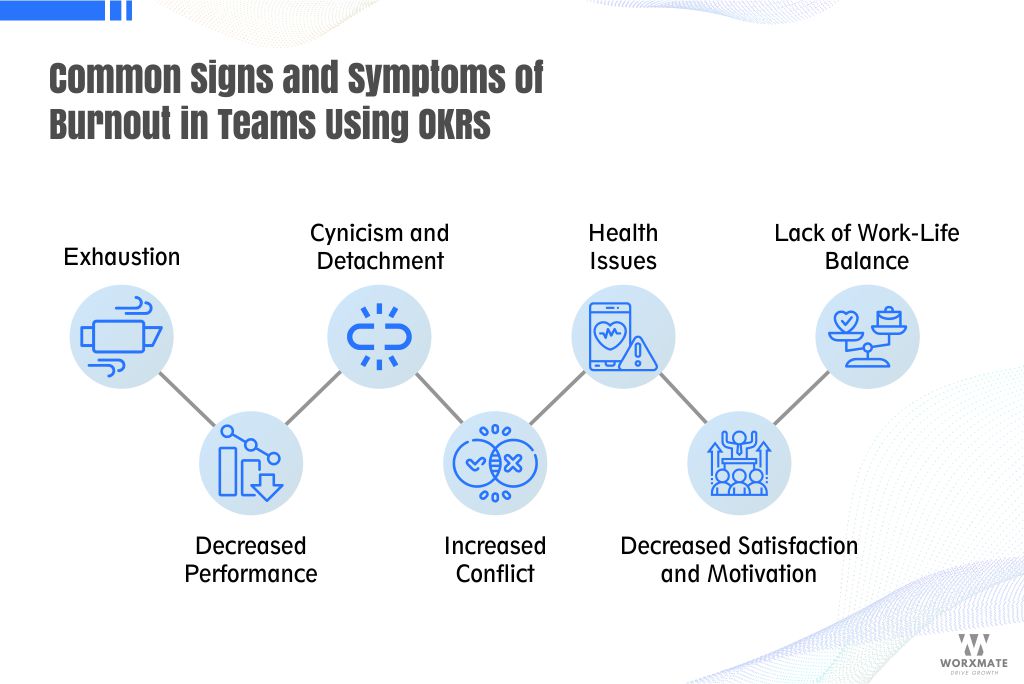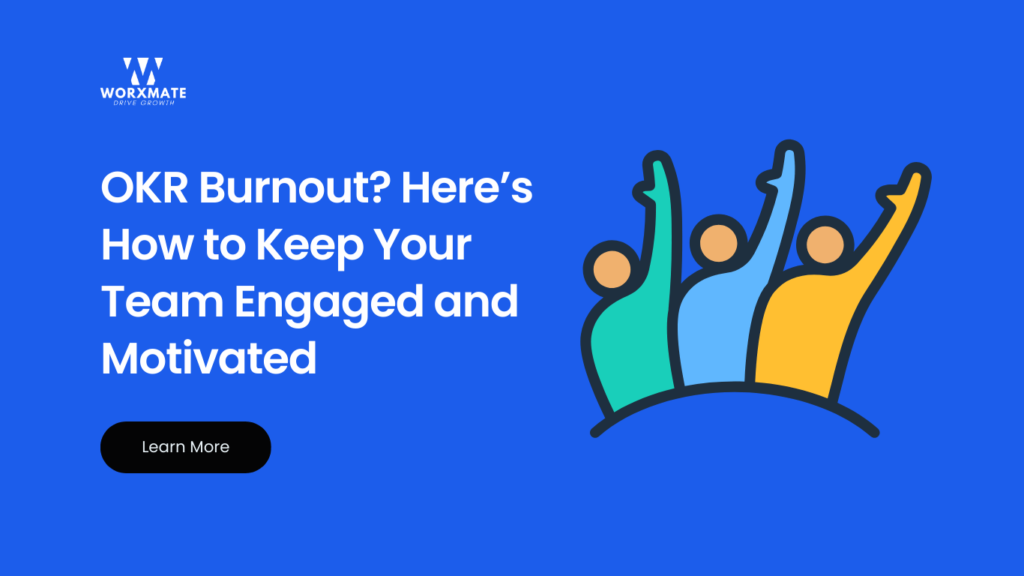According to a recent McKinsey Health survey of 15,000 workers in 15 countries, 25% of the workforce reported having symptoms of burnout. So, as we embark on this strategic journey to achieve our organizational goals, it’s crucial to recognize that the pursuit of success should not come at the cost of team burnout.
In this blog, we’ll delve into the art of balancing ambition and well-being, exploring effective strategies to maintain team motivation while avoiding the pitfalls of OKR burnout.
Why OKRs are important in an Organization: An Overview
Acting as a dynamic roadmap, OKRs align teams and individuals with overarching goals, fostering a shared sense of purpose. The brilliance of OKRs lies in their ability to blend qualitative aspirations (Objectives) with measurable outcomes (Key Results).
This framework enhances clarity and transparency and fuels a culture of continuous improvement. By setting ambitious yet achievable targets, OKRs drive innovation, focus, and collaboration, providing a robust structure for organizations to adapt, excel, and thrive in the ever-evolving business landscape. In short, OKRs aren’t just goals; they are the fuel that propels organizations toward excellence.
The Crucial Role of Team Motivation in Successful OKR Implementation
In the journey of implementing OKRs within an organization, the significance of team motivation cannot be overstated. OKRs operate on the principle of setting ambitious yet achievable goals; for these goals to be reached, teams must be aligned and highly motivated.
Teams are more likely to embrace the challenges presented by OKRs with enthusiasm, fostering a culture of collaboration, innovation, and commitment. When team members are motivated, they are better equipped to overcome obstacles, adapt to changes, and contribute their best efforts toward achieving the set objectives.
In essence, team motivation is the driving force that propels the successful execution of OKRs, ensuring that everyone is not only on board but also eager to surpass expectations and collectively propel the organization toward its strategic goals.
Understanding Burnout in the Context of OKRs
While OKRs are a powerful tool for goal-setting and performance improvement, they can inadvertently contribute to burnout if not managed effectively. The intense focus on achieving ambitious key results within a specified timeframe may lead to increased stress and pressure on individuals and teams.
Burnout in the context of OKRs can result from unrealistic expectations, lack of resources, or a constant drive for high performance without sufficient attention to well-being.

Common Signs and Symptoms of Burnout in Teams:
-
Exhaustion:
Team members may exhibit signs of physical and emotional exhaustion, feeling drained and depleted of energy due to the relentless pursuit of challenging Key Results.
-
Decreased Performance:
Burnout can lead to a decline in overall team performance, as individuals find it increasingly challenging to meet the demanding expectations set by the ambitious Key Results.
-
Cynicism and Detachment:
Team members may become disengaged or cynical about their work, losing enthusiasm and passion as the pressure to achieve aggressive goals intensifies.
-
Increased Conflict:
Burnout can contribute to heightened tension and conflict within teams as stress levels rise and individuals struggle to cope with their demands.
-
Health Issues:
Physical health problems, such as headaches, insomnia, or other stress-related ailments, may become prevalent among team members experiencing burnout.
-
Decreased Satisfaction and Motivation:
The relentless pursuit of Key Results with proper consideration for well-being can decrease job satisfaction and motivation, affecting overall team morale.
-
Lack of Work-Life Balance:
A team’s ability to maintain a healthy work-life balance may be hampered by the pursuit of ambitious OKRs, eventually leading to burnout.
Key Factors Contributing to OKR Burnout:
-
Excessive Workload and Unrealistic Goals:
One of the primary contributors to burnout in the context of OKRs is an excessive workload coupled with unrealistic goals. When teams are constantly faced with challenging Key Results that require an unsustainable level of effort, it can lead to fatigue, stress, and, ultimately burnout.
- Lack of Clarity in Goal-Setting:Unclear or ambiguous Objectives and Key Results can contribute to burnout as team members need help in understanding their priorities and aligning their efforts. A lack of clarity can result in confusion, frustration, and a sense of being overwhelmed, exacerbating stress levels.
-
Insufficient Resources and Support:
Burnout can be fueled by a lack of resources and support necessary to achieve the set OKRs. When teams are not adequately equipped with the tools, training, or manpower required to meet ambitious goals, it can lead to frustration, demotivation, and a heightened risk of burnout.
-
Poor Communication and Collaboration:
Ineffective communication and collaboration within a team or organization can contribute to burnout. When there is a need for more transparent communication about progress, changes, or challenges related to OKRs, it can lead to misunderstandings, increased stress, and isolation in pursuing goals.
Strategies for Avoiding OKR Burnout
As organizations increasingly adopt OKRs to drive performance and achieve strategic objectives, addressing the potential risk of burnout among teams becomes essential. OKR burnout can result from factors such as excessive workload, unrealistic goals, and insufficient support. Organizations can employ the following strategies to ensure the success of OKR implementation while safeguarding the well-being of employees.
-
Setting Realistic and Achievable Goals:
Ensure that OKRs are realistic and achievable within the given timeframe. Avoid setting overly ambitious goals that may lead to excessive workload and stress. Realistic objectives foster a sense of accomplishment and reduce the risk of burnout.
-
Prioritizing and Focusing Efforts:
Encourage teams to prioritize their efforts based on the significance of key results and alignment with overall objectives. By focusing on high-impact activities, teams can avoid spreading themselves too thin and reduce the likelihood of burnout.
-
Regular Check-ins and Feedback:
Implement regular check-ins and feedback sessions to monitor progress and provide support. This helps identify challenges early on and allows for adjustments to goals or resource allocation, preventing prolonged stress and burnout.
-
Celebrating Achievements:
Recognize and celebrate both individual and team achievements. Acknowledging milestones and successes boosts morale, fosters a positive work environment, and reinforces the sense of purpose, reducing the risk of burnout.
Conclusion
In the quest for achieving our OKRs, let’s keep sight of the human element. By implementing these strategies, we can foster a motivating and sustainable environment, ensuring that our teams thrive without succumbing to the perils of burnout.
After all, the journey is just as important as the destination, and a motivated team is the driving force behind every successful OKR implementation. Here’s to conquering objectives, nurturing well-being, and building a resilient, high-performing team!
Setting ambitious goals is great, but without the right approach, OKRs can feel overwhelming. WorxMate’s OKR tracking software helps you set, track, and achieve goals without the stress!




